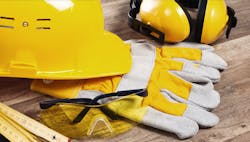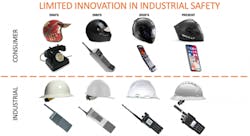Why safety tech is often a bad fit: Making workers the focus of safety solutions
The industrial worker safety sector has never been stagnant, but improvement has been too slow, for too long. In 1970, an average of 38 workers in the U.S. died each day, according to OSHA. In 2019, that number dropped to 15 deaths a day. This marked improvement is the result of great effort, but the current state remains unacceptable. Every workplace death is one too many.
How to perform a safety risk assessment
Safety training and PPE are not first-lines of defense
Industry standards of care during COVID-19
To date, two primary ways industrial companies have been able to improve safety and compliance are: 1) by creating awareness; and 2) deploying technology. When you consider the hierarchy of controls, the majority of these efforts have been focused on the bottom two levels: PPE to protect workers, in the form of additional coverings and sensors; and administrative controls to change worker behavior and processes, such as checklists, reminders, posters, trainings, and the like.
The problem is, we are managing the majority of risk at the least effective level. For those not deeply involved in EHS, consider the example of a cookout.
- Elimination: Fire can burn, so the most effective solution is to eliminate it. Bring food that doesn’t require cooking, and no cooks will be burned.
- Substitution: This could mean finding an outlet and using a microwave. The fire is replaced with an alternative solution without the hazard.
- Engineering: An engineered solution could be a grill that keeps the flame or heat source away from and unreachable by the cook. If this doesn’t exist, it’s a good idea and someone should invent it. In all three of these solutions at the top of the hierarchy of controls, actions by the cook, or anyone nearby, are removed from the equation of harm.
- Administrative: These controls rely on our cook to change the way they work, to follow smart grilling or fire protocols, such as do not grill close to a structure, stay near the heat source at all times, but not too close, keep flammable material at a distance, etc.
- PPE: For our cook PPE could be hot pads, long sleeves, or the like. Judging by the nearly 20,000 people burned grilling each year in the U.S. alone, PPE and administrative controls alone are not effective. Someone really needs to invent this burnless grill and move us up to engineering controls to keep our cooks safe, without making grilling too difficult and taking all the fun out of our cookouts.
Zooming back out, it is time for worker safety to take a leap forward in this same way, to move beyond cumbersome equipment and posters, and leverage the new technology available to bring more risk into the realm of engineered control. However, as we do this, we face another obstacle to adoption and effectiveness. Too much of new technology for industrial safety ignores the worker, the most crucial piece of the puzzle in worker safety. Many new solutions are IIoT based, but workers are not “things.”
I used to run steel operations across North America for a major global producer. I’ve seen some of my most experienced colleagues bypass PPE and safety processes. I’ve seen them skate by without consequence.
When we deploy safety solutions, we have to ask, “Are they built around the way workers work, or do they force the worker to adapt to them?” “Are the concerns of the workers adequately addressed as these solutions get implemented?” “Are the solutions being implemented to address compliance questions, or are they genuinely focused on worker safety?”
Worker concerns
To answer these questions, let’s look at the common concerns that workers have regarding safety solutions.
Privacy. Safety solutions like wearables, sensors, and real-time location systems (RTLS) help companies monitor the workplace in real-time and send timely alerts to workers as they near a hazardous site or come close to moving equipment. Workers are often hesitant to adopt these solutions because they are concerned about privacy. How, when, and where will their employers monitor them? Most data solutions can be set up to protect a users’ identity. However, for safety solutions to be effective they need to be able to identify each worker, at least in certain situations like an SOS or evacuation. Some workers are also unaware of their rights with regards to data privacy, or even worse, their managers might be unaware and misuse their data. Workers do not want to be spied upon, and companies must respect that. They need to strike a balance between protecting the workers’ privacy and ensuring safety with real-time alerts and emergency responses.
User experience (UX). Although companies have been investing in technology solutions to improve workplace safety, the truth is most are uncomfortable or inconvenient to use. If their jobs are made harder, or they are made less productive due to a new technology, it will not be used. They need a solution with shallow learning curves, one that seamlessly fits into their current processes, or clearly and immediately creates better ones. It must simplify their daily operations. Their jobs are already hard enough, do not complicate them further.
Fit for the environment. Industrial workplaces are different from typical workplaces. Many contend with extreme weather conditions, remote or isolated environments, spotty or no network connectivity, chemical and physical hazards, heavy vehicles, and equipment. Therefore, technology solutions must be equally as rugged, created especially for such tough conditions. For example, smart, connected, or IIoT devices need to be built to find connectivity—WiFi, cellular, UWB and more—as well as have the option to store data onboard, and send later should connectivity be disrupted. If you think dropped calls are annoying, try dealing with it when conducting maintenance at an offshore rig where every minute of downtime can run thousands of dollars, or even put lives at risk.
This article is part of our monthly Your Space column. Read more from our Your Space series.
So, now what? Every industrial company can take steps to make it easier to vet, deploy, and adopt worker-centric safety technology going forward.
- Create and adhere to data privacy policies. Companies must make data security and compliance mandatory. Data should be processed ethically and should only be used for the purpose it was intended. Robust encryption strategies must be in place to avoid data leakage. Data must be backed up regularly. Most importantly, companies must communicate with their workers, early, often, and regularly. To give them confidence that the data is being used for their security, not to spy on them at work.
- Build UX into specs. Companies must ensure that their safety solutions are easy to learn and are intuitive for workers to use. Special attention must also be paid to worker needs—do workers require hands-free solutions, remote access, or a certain number of clicks to give functionality? Technology companies don’t get a pass on UX because they are selling into industrial markets. If anything, the high-risk nature of these applications means that this technology should be easier to use compared to consumer technology. Also, workers will be more apt to adopt a safety solution that improves their ability to collaborate, and get their job done efficiently.
- Ensure solutions can survive and thrive in extreme conditions. Solutions should be able to work offline and be relied upon in extreme conditions. All safety solutions should be tested in real-life situations to ensure that they will operate effectively in all environments. You are asking your workforce to trust you with their safety. They need to know the solutions meant to keep them safe will not let them down when they need them most.
One-hundred-page compliance guides and recurrent, intensive trainings have taken us a long way since the 1970s, but these cannot guarantee worker safety. We need to adopt solutions that stop asking our workers to bear the brunt of the safety burden. We also must do more than simply throw shiny, new technology at problems and call them engineered controls.
Instead, we need engineered solutions that center on the worker. We need solutions that know what to do with the type of unstructured data people make and use—audio, video, biometric, and beyond. We need an Industrial Internet of People (IIoP) to go with our IIoT. We need technologies that rise to the challenge of industrial operations, but however extreme the environment, intensive the operations, or technologically advanced the equipment, the worker is the focus of safety solutions.
This story originally appeared in the May 2021 issue of Plant Services. Subscribe to Plant Services here.
Saikat Dey is the co-founder and CEO of Guardhat, a pioneer of end-to-end connected worker and safety solutions. Prior to Guardhat, Dey was the CEO of Severstal North America; he also worked at McKinsey & Company and co-authored the book, Uncommoditized, on commodities markets in modern economies. He holds an MBA and a BS in Mining Engineering.

